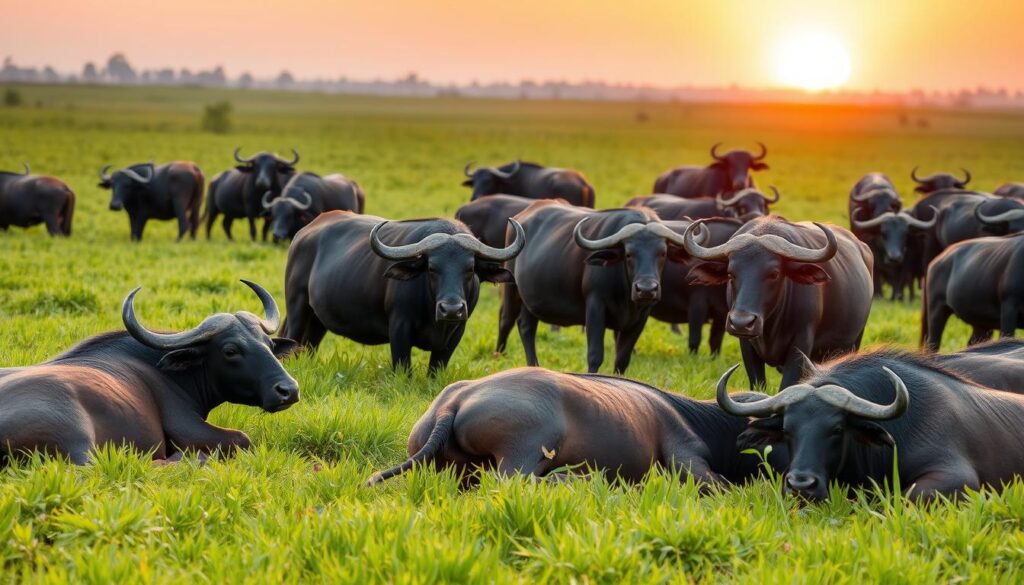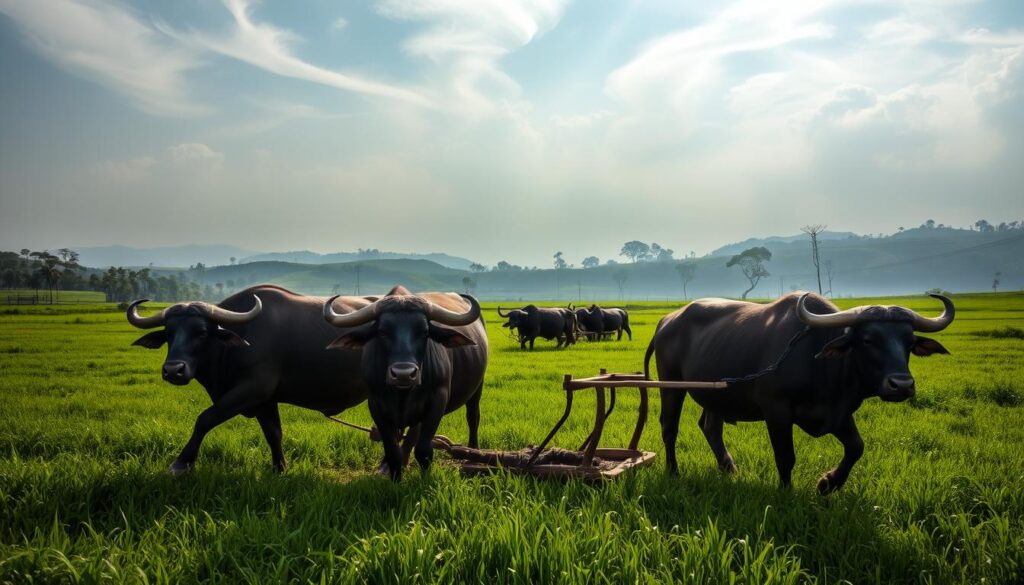Are Water Buffalo Friendly
Did you know there are over 200 million water buffalo worldwide? They outnumber domestic cattle by a huge margin. These massive animals come from the Indian subcontinent and Southeast Asia. They are often seen as strong and possibly dangerous. But, surprisingly, water buffalo are usually friendly and calm.
Water buffalo can be unpredictable, like when they’re protecting their young. But, they’re not usually a threat to people unless they feel threatened. With the right care, they can even be good companions. But, they’re too big and strong to be pets.
Water buffalo tend to ignore or show curiosity towards people, not aggression. Their gentle nature makes them great for hard work in Asia. So, while they need respect, they’re not hostile. They can be friendly if you approach them carefully and understand them.
Introduction to Water Buffalo
The water buffalo (Bubalus bubalis) is a large bovine species from the Indian subcontinent and Southeast Asia. These animals have been important in agriculture and culture for thousands of years. Knowing about their origins, domestication, and unique traits helps us understand their value and role today.
Origins and Domestication
Water buffalo were domesticated from wild water buffalo (Bubalus arnee) around 2500 BC. Over time, they were bred to live well in Asia’s wetlands. There are two main types: river buffalo and swamp buffalo, each with its own look and behavior.
Water Buffalo vs Other Buffalo Species
Water buffalo are similar to other buffalo but are uniquely suited to water. They have curved horns and love to wallow in mud and water. These traits help them survive in wet environments.
| Characteristic | Water Buffalo | Other Buffalo Species |
|---|---|---|
| Habitat | Wetlands, marshes, and shallow waters | Grasslands, savannas, and forests |
| Horns | Curved, lyre-shaped | Straight or slightly curved |
| Body Shape | Stocky, with a large, muscular body | Leaner, with a more elongated body |
| Adaptations | Specialized for wading and wallowing in water and mud | Adapted for grazing in drier, open habitats |
Physical Characteristics of Water Buffalo
Appearance and Size
Domesticated water buffalo come in many colors, like black, grey, and even albino. They have long, curved horns and flat backs. This makes them different from other buffalo, like the American bison with its hump.
River buffalo have longer faces and smaller bodies than swamp buffalo. Swamp buffalo are stockier and heavier.
Water buffalo are truly giants. Bulls can be over 6 feet tall and weigh up to 2,200 pounds. Cows are slightly smaller but impressive, standing 4-5 feet tall and weighing 660-1,210 pounds.
| Subspecies | Weight Range | Length Range | Shoulder Height Range |
|---|---|---|---|
| Cape Buffalo | 500-900 kg | 1-2 m | 1-1.7 m |
| Water Buffalo | 700-1200 kg | 2.4-2.7 m | 1.5-1.9 m |
The water buffalo was domesticated over 5,000 years ago. It has been used for transportation and ploughing. The Cape buffalo, on the other hand, is wild and aggressive, not yet domesticated.
Temperament and Behavior of Water Buffalo

Water buffalo are known for their calm and docile nature. Water buffalo rarely show aggression unless they feel threatened or need to protect their young. They spend most of their time grazing or enjoying a mud bath, not looking for fights.
But, water buffalo can be unpredictable at times. Males, in particular, may get aggressive during mating season. With the right care, domesticated water buffalo are safe and manageable. But, their size means they should be treated with caution, as their behavior can change depending on the situation.
The water buffalo personality is calm and docile, often showing indifference to humans. Their water buffalo docility makes them easy to handle. But, their size and occasional water buffalo aggression during specific times require careful handling and care.
Why are Water Buffalo Called “Water Buffalo”?

Water buffalo got their name because they love water. They can’t sweat well in hot weather. So, they spend a lot of time in water or mud to cool down and protect their skin.
They use their horns to dig and wallow in mud. This mud layer keeps them warm. Their big, wide hooves also help them stay on top of soft ground. This makes them very good at living near water.
Mud wallowing does more than just cool them down. It also keeps parasites and sunburn away. Their wide hooves help them stay steady in wet places. This close connection to water makes them great for work and food in Asia and other places.
Water Buffalo as Draft Animals

Beyond their celebrated role as milk producers, water buffalo have long been esteemed as invaluable draft animals throughout Asia. Their immense size and strength make them ideally suited for arduous tasks. These include plowing rice fields, pulling carts and lumber, and powering various low-tech agricultural devices. In fact, water buffalo are estimated to provide up to 20-30% of the total draft power used in Asian agriculture.
The water buffalo’s docile nature and willingness to work tirelessly have endeared them to farming communities for centuries. These hardy, adaptable creatures have been an integral part of agricultural and transportation systems across many Asian cultures. This highlights their versatility and importance as domestic livestock.
- Over 130 million domestic water buffalo exist globally.
- Water buffalo have been domesticated for over 5,000 years.
- Water buffalo are utilized for draft, meat, and milk purposes.
The water buffalo’s role as draft animals in agriculture highlights their unique value. They have shared a symbiotic relationship with humans for millennia. From plowing fields to powering essential machinery, these gentle giants have been indispensable partners in the development of many Asian societies.
Water Buffalo Milk Production
Water buffalo are big milk producers, making up over 5% of the world’s milk. Their milk has more fat and protein than cow’s milk, making it creamier and more nutritious. In Asia, it’s a key food, used for butter, cheese, and yogurt.
Nutritional Benefits of Water Buffalo Milk

Water buffalo milk is packed with calcium, vitamins A and B, and essential fatty acids. Its rich composition makes it a favorite dairy product globally. It has only A2 beta-casein protein, which is healthier than cow’s milk.
This milk is great for bone health and might lower osteoporosis risk. A study found it has more antioxidants than cow’s milk. It also has beta-lactoglobulin and potassium, which can help with high blood pressure.
| Nutrient | Water Buffalo Milk | Cow Milk |
|---|---|---|
| Fat (g/100g) | 7.4 | 3.3 |
| Protein (g/100g) | 4.5 | 3.2 |
| Calcium (mg/100g) | 195 | 120 |
| Vitamin A (IU/100g) | 210 | 126 |
| Vitamin B12 (mcg/100g) | 1.2 | 0.4 |
Most buffalo milk comes from India and Pakistan, followed by China, Egypt, and Nepal. It’s also found in Mediterranean countries like Italy, where it’s used for cheese.
Are Water Buffalo Friendly
Interactions with Humans
Water buffalo are often seen as friendly and calm, thanks to proper care from humans. Despite their large size, they usually don’t attack people. Instead, they like to eat grass or splash in mud.

They can safely interact with humans if treated with care. But, they shouldn’t be pets because of their power and unpredictable nature.
Water buffalo might get defensive when protecting their young or during mating. So, it’s important to be careful around them. They are not usually dangerous, but their size demands respect.
With the right precautions, water buffalo can live peacefully with humans. They are great for farm work or even tourist activities.
In places like Hoi An, Vietnam, riding water buffalo is a hit with tourists. Local farmers, trained in English and customer service, lead these tours. It’s a fun way to see the friendly side of water buffalo and help farmers earn extra money.
Water buffalo might not be good pets because of their size and strength. But, they are wonderful partners for farm work and fun activities. By understanding them, we can enjoy their company safely and responsibly.
Wild vs Domesticated Water Buffalo
The wild water buffalo (Bubalus arnee) is the original form of the domesticated water buffalo. It is found in small, endangered groups in India and Southeast Asia. Despite their similarities, wild and domesticated water buffalo have key differences.
Wild water buffalo are bigger and more fierce than their domesticated friends. They like to be alone, living in dense forests and marshes. On the other hand, domesticated water buffalo are tamer and bred for work and milk.
| Characteristic | Wild Water Buffalo | Domesticated Water Buffalo |
|---|---|---|
| Size | Larger, with a shoulder height of 1.5m to 1.9m | Smaller, with a shoulder height of 1m to 1.7m |
| Weight | 700kg to 1200kg | 500kg to 900kg |
| Temperament | More aggressive and solitary | More docile and better suited for agriculture |
| Population Status | Endangered | Robust, with an estimated 200 million individuals worldwide |
The wild water buffalo is listed as Endangered by the IUCN. Yet, the domesticated water buffalo is doing well, with about 200 million worldwide. Efforts are being made to save the wild buffalo to keep this ancient species alive.
Water Buffalo in Different Regions
The water buffalo is a key part of Asia’s agriculture and culture. Over 95% of the world’s water buffalo live in Asia. Countries like India, China, and Pakistan have the most. They are used for work, milk, meat, and leather.
Asia
Asia is where most water buffalo live. About 160 million water buffalo exist globally, with 150 million in Asia. India has 109 million, making up over two-thirds of the world’s population.
These animals do well in Asia’s varied climates and landscapes. They live in India’s river valleys and China’s marshes.
Europe
Water buffalo also live in Europe, but in smaller numbers. Italy is famous for its water buffalo, whose milk makes mozzarella cheese. In the Balkans, there are fewer water buffalo than in Asia.
Australia
Australia has a feral water buffalo population from the late 19th century. These animals have adapted to the Australian outback. They live in the Northern Territory and other areas.
Though not as common as in Asia, Australian water buffalo are important in the region’s farming and ecology.
| Region | Water Buffalo Population | Percentage of Global Population |
|---|---|---|
| Asia | 150 million | 95% |
| Europe | Smaller populations in Italy and the Balkans | Less than 5% |
| Australia | Feral population in Northern Territory and other regions | Less than 1% |
Water Buffalo Ecology and Diet
Water buffalo thrive in tropical and subtropical areas. They love places with lots of water and green plants. They live in wetlands, marshes, and flooded rice paddies. Here, they can cool down by wading in the water.
These animals only eat plants. They help control invasive plants by eating them. Water buffalo prefer to graze in wet areas. They can even eat plants while their heads are underwater.
Grazing Habits
Water buffalo are closely tied to water. They live in tropical places where they can eat lots of plants. They can eat plants while swimming, which is unique.
| Dietary Preferences | Habitat Adaptation |
|---|---|
| Aquatic plants, grasses, and other forages | Wetlands, marshes, and flooded rice paddies |
| Submerged vegetation | Ability to wallow and regulate body temperature |
| Control of invasive plant species | Thriving in tropical and subtropical climates |
Water buffalo have a special place in their ecosystems. Their diet and habits help shape their environments. They are a key part of the natural world.
Reproduction and Lifecycle
Water buffalo have a unique breeding pattern. They mate at specific times of the year. Young males are ready to breed at 3-3.5 years old. Females can start breeding as early as 13-33 months, but often wait until they are 3 years old for their first successful mating.
The gestation period for water buffalo is 300 to 320 days. Swamp buffaloes carry their calves a bit longer than river buffaloes. Water buffalo can breed well into their old age, staying productive even past 30 years old. This makes them different from other domesticated animals.
| Reproductive Trait | Range |
|---|---|
| Age at Sexual Maturity (Males) | 3-3.5 years |
| Age at First Breeding (Females) | 13-33 months |
| Gestation Period (Swamp Buffaloes) | 300-320 days |
| Gestation Period (River Buffaloes) | 300-320 days |
| Reproductive Lifespan | Up to 30+ years |
The long reproductive lifespan of water buffalo is a big plus. It lets them stay productive for decades. Their ability to eat a wide range of forage makes them valuable in sustainable farming around the world.
Conclusion
The water buffalo is a remarkable animal that has been important to people in Asia for thousands of years. They are known for being friendly and strong. These traits make them great for work, milk, and helping with farming.
Even though wild water buffalo are struggling, the ones raised by humans are doing well. In 2020, there were over 200 million domesticated water buffalo worldwide. This shows how important they are in Asian culture and farming.
Water buffalo are more than just big, muddy animals. They are hardworking and have helped shape the lives of many. They can run fast and their milk is healthier than cow’s milk. These amazing animals continue to help people all over the world.




